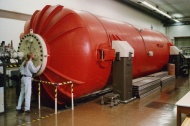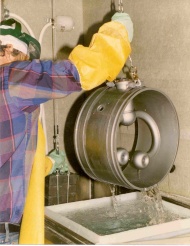Difference between revisions of "Main Page"
| Line 12: | Line 12: | ||
|width="50%" style="border: 1px solid #aaa; color: #000; background-color: #ffffcc"| | |width="50%" style="border: 1px solid #aaa; color: #000; background-color: #ffffcc"| | ||
<div style="padding: .4em .9em .9em"> | <div style="padding: .4em .9em .9em"> | ||
| − | The Center for Accelerator Science and Education (CASE) will | + | The Center for Accelerator Science and Education (CASE) will be hosting an '''Accelerator Physics Workshop''' for high school physics teachers and students from July 26 - July 30 2010. |
</div> | </div> | ||
|} | |} | ||
| Line 21: | Line 21: | ||
<div style="padding: .4em .9em .9em"> | <div style="padding: .4em .9em .9em"> | ||
| − | == | + | == Accelerator Physics Workshop == |
| − | + | * Dates: July 26th { July 30th, 2010 | |
| − | * | + | * Time: 9:00 - 4:00 (1 hour for lunch) |
| − | [[ | + | * Application Deadline: June 7th, 2010 |
| − | + | * Instructor: [[ThomasHemmick | Dr. Thomas K. Hemmick]] Distinguished Teaching Professor and Co-director of the Center for Accelerator Science and Education | |
| − | + | ** Assisted by [[User:RichardLefferts | Mr. Richard S. Lefferts]] Director of Operations, Stony Brook University Nuclear Physics Laboratory and Ms. Taposhi Biswas, MAT Physics Candidate Stony Brook University | |
| − | + | * Place: Stony Brook University, Brookhaven National Laboratory | |
| − | * | + | * Fee: Free of charge. |
| − | * Stony Brook University | + | * Maximum Enrollment: 20 students; unlimited slots for teachers. |
| + | * Credits: 30 hours/2 in-service credits | ||
| + | * Target Audience: High school physics teachers and students | ||
</div> | </div> | ||
| Line 35: | Line 37: | ||
<div style="padding: .4em .9em .9em"> | <div style="padding: .4em .9em .9em"> | ||
| − | ==The | + | ==The Program== |
| − | + | Accelerators are complex and versatile machines, whose applications are generally thought to | |
| − | + | be restricted to the realm of high-energy physics. However, the vast majority of accelerators are | |
| − | + | currently being used in the areas of medical physics and industry. Most notably, research has shown | |
| − | * | + | that accelerators are capable of providing medical treatments that produce results incomparable |
| − | * | + | to any other modern techniques, and therefore they (and the scientists that operate them) are |
| − | * | + | indispensable resources. |
| − | * | + | |
| − | * | + | In this one-week workshop, participants will: |
| − | + | * become familiar with the structure of the atomic nucleus | |
| − | + | * learn about the mechanics of nuclear decay, accelerator mass spectroscopy | |
| − | + | * explore the medical applications of accelerator physics | |
| + | * understand the mechanics of an accelerator | ||
| + | * design and utilize methods of manipulating and focusing a beam of charged particles | ||
| + | * implement the <sup>27</sup>Al (p,n) <sup>27</sup>Si and <sup>1</sup>B (p,n) <sup>11</sup>C nuclear fusion reactions | ||
| − | |||
</div> | </div> | ||
|} | |} | ||
Revision as of 10:57, 7 May 2010
Center for Accelerator Science and Education |
|
The Center for Accelerator Science and Education (CASE) will be hosting an Accelerator Physics Workshop for high school physics teachers and students from July 26 - July 30 2010. |
Accelerator Physics Workshop
|
The ProgramAccelerators are complex and versatile machines, whose applications are generally thought to be restricted to the realm of high-energy physics. However, the vast majority of accelerators are currently being used in the areas of medical physics and industry. Most notably, research has shown that accelerators are capable of providing medical treatments that produce results incomparable to any other modern techniques, and therefore they (and the scientists that operate them) are indispensable resources. In this one-week workshop, participants will:
|
Research OpportunitiesCASE faculty are involved in many exciting projects. Please contact us for more information.
|
Past ProjectsFirst on its own and then as an injector to the Superconducting Heavy Ion Linac, FN-8 was used for Nuclear Physics research at Stony Brook for 40 years.
The Stony Brook Superconducting Heavy Ion Linac was commissioned in 1983 and used until 2007. Superconducting RF research at Stony Brook led to the development of the SQWR, the SRFQ and the CPM based SRF controller, among other achievements.
|

